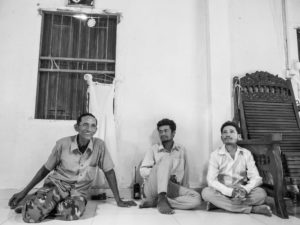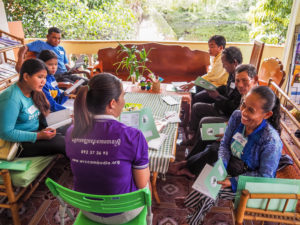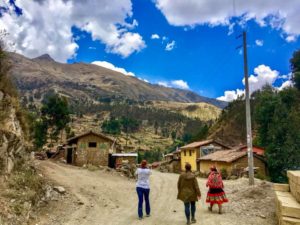“Wisdom is about understanding big truths in a deeper way.” – Melinda Gates
December is a perfect time to reflect on the past year, to deeply consider salient questions about our personal, professional, and organizational development. As WECO makes plans for new projects in 2020, we’ve stopped to review our work thus far and where it fits into the bigger picture of equity and empowerment. Like so many development organizations, we want to prioritize making stronger partnerships and creating richer volunteer experiences so we can better achieve our mission of supporting women and girls around the world. We strive to use the resources we have to empower community workers who empower their communities. It’s been a winding road, at times – one full of learning and growth.
In order to give plenty of space to this (very broad) topic, we decided to break it down into five questions over a two-part post. Answers to these questions are formed from both our experience and through various insights offered by authors who are well-versed in issues of equity and empowerment. At the end of Part II, we’ve included a list of our favorite reads from 2019. It is our goal that, by keeping these questions at the front and center of our work, we can stay on the right track in doing effective, ethical, and empowering work with communities we support.

Women’s rights activists in Cambodia
Question #1: Where are the gaps in equity and empowerment work?
“It was possible, I knew, to live on two planes at once: to have one’s feet planted in reality but pointed in the direction of progress. For me, becoming isn’t about arriving somewhere or achieving a certain aim. I see it instead as forward motion, a means of evolving, a way to reach continuously toward a better self.” – Michelle Obama
The world as it is needs improvement. Michelle Obama reminds us how we can live in this world while continuing to work to create the world as it should be: a new world, a better one. The key will be crafting an honest narrative as we build this new world, and engaging every character in the story of social change.
For starters, we can avoid the Hero Narrative that’s full of colonial overtones, while also refraining from diving too deep off the Cliff of Criticism. Somewhere in the middle is a place where we can take a hard, compassionate look at the motivations and outcomes of equity work – including volunteering abroad – and keep mobilizing with a focus on solutions. Volunteering abroad is a good solution to global inequity. It’s not the only answer, and yet it is one that operates in a complex space and – when done well – empowers communities while empowering travelers to be more responsible. Good organizations know there’s room for improvement and seek honest feedback from volunteers and community workers.
Part of creating a more well-rounded story of equity and development is the language we use to describe our work. Words like collaboration and partner are said to the point where they, at times, lose their meaning. Competition to build attractive marketing or fundraising campaigns is one reason for this, as organizations seek to find buzzwords that produce a larger audience or following – but often in a way that threatens to dissolve the essence or value of the cause itself. It can be hard to know who – and what – to trust in the age of social media, if words are not supported by authentic action.
Beyond language used in marketing, there is a larger illusion that extends to include the entire industry of philanthropy, specifically in regards to how people with the resources approach giving. In Winners Take All, Anand Giridharadas overviews how the private sector tends to create development initiatives in their own image, or in a way that reflects implicit biases. He refers to mainstream social entrepreneurs primarily as plutocrats who project corporate self interest, and who monopolize progress as a means of improving their own image. In no real way, he argues, do these initiatives disrupt the status quo because they do not actually address underlying economic inequities. In most cases, their initiatives do just enough to take the edge off of public anger. These rich and powerful people build platforms on changing the world when essentially what they do is leave it the same.
Inherent in the existing structure of philanthropy – one that embraces the current model of capitalism – is the idea that inequality is a cost of progress. This mindset assumes there must be losers in order to be winners – and, the fewer the winners, the larger the gains. We live in a world where the top 10% hold nearly 90% of global wealth. It is an elaborate illusion, the idea that solutions derived from this kind of capitalism will, in any real way, challenge power; what it does in actuality is protect and further amass it for those who hold it. This unquestioned hegemony exists in the guise of social betterment and is merely “a continuation of the colonial, imperial arrogance of the enlightened white man with money and science, and noble and benevolent intentions, who will solve these problems.” Giridharadas quotes Ramdas to describe this problematic narrative as one that “[tries] to solve the problem with the tools that caused it.” In other words, you can’t use the status quo to disrupt it.
If funders are going to ask how “their money” is spent by poor people they’re supporting, why don’t they also (or instead) focus on how they got that money in the first place? We rarely question the origin of donor money and yet it’s standard practice to scrutinize – to the dollar – the impact of it for communities in need. We don’t – as a practice – examine what other things wealthy people spend their money on, either. These are but a few examples of the abstract, negative contributions from modern philanthropy that perpetuate harm for its recipients.
To really make progress, it will take being disruptive, asking good questions, and getting uncomfortable as we examine our assumptions and philanthropic traditions. As a culture, we need to bend the demand curve towards justice instead of prioritizing how to meet the wealthy where they are. Generosity will never be a good substitute for justice. Philanthropy shouldn’t be defined by helping wealthy people move away from guilt so they can justify how they got their wealth.

Program coordinator, Kimsan, holds a workshop at the WRC
Question #2: What does good philanthropy look like?
“Building solidarity among different communities and causes is what allows us to deepen our perspectives and create the kind of long-term, systemic change that can only be accomplished with a collective approach.” – Carly Hare
Darren Walker, President of the Ford Foundation, expresses his philosophy of philanthropy as one that encompasses listening to, learning from, and lifting up underserved communities. A key part of this process is, in some way, removing authority from people in charge of making philanthropic decisions. In his book, From Generosity to Justice, Walker explains how decades of charity, while serving an urgent need, hasn’t done enough to change the underlying systems that make philanthropic work necessary. If charity is like treating the symptoms of an illness, justice can be understood as addressing the underlying conditions that create it. The act of charity is necessary in addressing immediate need; but justice is the lasting outcome we all should strive for.
One of Walker’s key points is how donors should not treat beneficiaries as objects of charity, but rather as drivers of change. Wealthy people shouldn’t feel entitled to decide what’s best for society just because they hold the resources. Corporations who espouse corporate social responsibility need to value stakeholders as much as they value profits for shareholders. If there is a widespread shift in attention to listen to the voices of those most affected by injustice, then we can more effectively cure the causes of it. This is a process that must be inclusive and intersectional in practice by accounting for every angle and every lens.
While privilege can’t necessarily be changed or fully controlled, it can be recognized and acknowledged responsibly. As Walker describes, “unique communities require unique solutions…to effectively address systemic problems, we have to familiarize ourselves with those whom we are trying to help.” This means we focus on building programs from the bottom-up while dispersing resources and decision-making from the top-down. It also means organizations quit putting too much weight on strategic advice and innovative solutions from technocrats to avoid what William Easterly describes as the “tyranny of experts.” The fact of the matter remains that nothing can replace the perspectives that promote actual, lived experience.
The heart of philanthropy is to balance unfairness, which involves reducing the winnings of the winners in order to effectively redistribute wealth, and we won’t get there by applying the same principles onto beneficiaries that made the wealth in the first place. If we only back the development “winners” we’re prioritizing success defined by the wealthy versus the needs of the undeserved. Even worse, inherent in this dichotomy is the belief that the “losers” are in some way responsible for their plight. In light of how growing income inequality destabilizes entire nations and how the greatest hardships fall on those who are most disadvantaged and structurally marginalized, organizations should prioritize mobilizing communities from the bottom up. Development work should be focused on leveling the uneven playing field instead of making more work for local community workers to fit within existing power structures by crafting impact reports that are designed to interest, convince, and satisfy those with the opportunity, resources, and access.

WECO’s site visit to Huilloc, Peru
Question #3: What does it mean to be a good partner, and how can donor organizations improve?
“Listening can help us more intimately understand our institutional ignorance and biases, and allow us to learn about how we can do better for our grantees and communities.” – Darren Walker
Read the full text Listening for Change, here.
We know the path forward for social change is justice, education, and economic empowerment; but we also know that path needs to be decided by the people for the people, not by the people who hold the most wealth. Real partnership is much more complicated than fitting philanthropy into business as usual. It’s a commitment to accountability and to authentic generosity, which is when the giver sacrifices something meaningful for someone else’s benefit.
Small, local, nonprofit organizations are closest to people in need; they are more directly linked to communities and more deeply involved in problem-solving and solution-making. They have processes that honor a community’s sense of dignity because they listen to their stories and needs. What these organizations may lack in impressive statistics and organizational design, they make up for by being integrated in their communities and the realness of their connection to them.
The problem is, smaller organizations are often overlooked or overburdened by funders who want guarantees or metrics on their social investments. These aren’t always feasible for local nonprofits in lower-income countries to produce because of the contexts that surround daily life. Often the very infrastructure of a place will create new problems that are difficult to solve. Organizations that survive over time develop a resiliency to these problems, but that doesn’t make them any easier to handle. Many of them do wonderful work in their communities, often in remote areas, and work hard to make a difference despite the hardships of doing so. They survive even when the stack is dealt against them.
Finding these local nonprofits takes pro-active outreach from the donor side. If more funders were to embrace this form of outreach, the future of development could be an exciting one. Imagine a network of small to medium nonprofits that works to identify other local organizations and support them through small grants. Imagine donors who listen, learn, and lift this network up by providing them with access to capital over time – and then get out of the way. These donor organizations could offer trainings (if prompted by communities), provide a platform for community decision-making, and simplify requirements to receiving funding, all so local nonprofits have both the support and the space to bring about positive change in their communities.
If funders really desire to learn as part of the giving process, then they can start by listening from the bottom-up. It can be hard for nonprofit workers to go against the grain of existing power dynamics, so this kind of change is best accomplished top-down. Rakesh Rajani with Co-Impact explains how we, as development leaders, can call each other out with respect and dignity by holding each other accountable to the ideals we’re trying to live by. We can ask ourselves, continuously, how we are changing our practice to be better partners and make adjustments based on community feedback. Rajani overviews the importance of donor organizations having self-awareness in how they interact with local nonprofits, specifically to avoid dominating the conversation and abusing their position of power through vices such as mansplaining, or it’s cousin, philanthro-splaining. If we really want to move towards an equitable world, partnerships will have to be values-drive more than profits-driven and focus on principles of honest collaboration by investing in local leadership.
